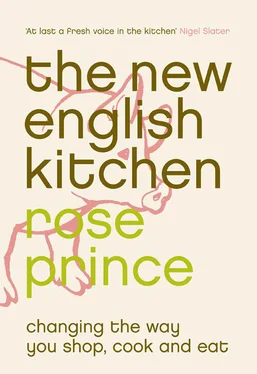The strained juice from canned tomatoes makes a wonderful Bloody Mary. For every 90ml/3fl oz juice, add a dash of Lea & Perrins, a pinch of celery salt, a shot of vodka, half a shot of sherry and as much Tabasco as you like – start with 2 drops. Shake in a cocktail shaker with ice.
A secret store-cupboard weapon. Canned artichokes come in brine, cost very little and taste bland – until you get to work with your olive oil, herbs, garlic and lemon juice. Eat them on toast, with chopped hard-boiled eggs or soft, fresh cheese.
bottled and canned sweet peppers
Much less fuss than roasting peppers yourself, bottled peppers in oil should be an ideal store-cupboard food but the majority of them are sour from undercooking and, worse, still have leathery skins attached. Go in search of Navarrico, a Spanish brand (see the Shopping Guide). The outlay for a can seems high until you realise that it contains over 20 genuine Spanish, sun-ripened, wood-roasted peppers in olive oil. They have so much flavour you need add only a few to a paella, or use a few at a time in Roasted Pepper Mimosa (see here).
Bacon is the most obvious example of British cured meat, with hams following closely behind. There’s a lot of dry-cured bacon about, but virtually no culture of dry-cured ham such as prosciutto at all. Every other European country has its dry-cured saucissons and salami ; its charcuteries and salumerie – where are ours? The answer, as explained to me by a successful English butcher, is very interesting: ‘We are happy to make sausages and bacon; they’re quick to make and we sell them fast. But why would we want to put money on a shelf for six months?’ Because you would reap more from it if you waited – there’s a real passion for this stuff and we are importing tonnes of it.
The analogy brings Tabasco to mind. Its Louisiana originator, Henry McIlhenny, made the first batch, then forgot about it for a year. When he came back to it, the sauce had fermented slightly and developed a mellow, mature flavour, though it still had the heat of red chilli. It has been made in the same way ever since. Long maturation gives Tabasco its subtle taste. Pity the poor Caribbean sauce makers. They make superb hot sauces but, try as they might, they cannot make a similar sauce or a similar sum of money because they cannot afford the time for maturation. It’s an attitude to aged food shared by most British meat curers. We are slowly but surely reviving genuine mature Cheddar and making better wine. But, with few exceptions, British butchers will never see the point of the great starter plate of thinly sliced, dry-cured meats and sausages, with a little pile of vinegary cornichons beside.
Cured meats such as chorizo, bacon and ham hocks are very useful in the New English Kitchen. They can be served as instant meals or used to flavour stews. Take advantage of British-based charcuterie makers (see the Shopping Guide) – your spending power will see others jump on to the bandwagon.
Herbs give so much to cooking. They lift and freshen dishes and, when matched to the right foods, they turn the flavour volume up – by this I mean they sing, not shout. Herb oil half stirred into a potato soup invades it with its flavours; the same beside grilled or roast meat, or spooned over boiled meats and offal, will make the grey-brown of the dish evaporate and give it a new vitality.
herbs and english cookery
Herbs have always belonged in English cooking. There is a general idea that the English are a nation of rehabilitated mistresses of the bland, rescued by Elizabeth David’s Book of Mediterranean Food in 1952. Wrong – David herself was perfectly aware of that, as her later books testified. If you believe some of what is said about English cooking, we are masters of roasting joints but otherwise stole everything from the French and Italians. Many people believe the first statement and are subsequently shamed into accepting the second. But this is not an argument about cookery – who made custard first, the English or the French – it is about the real tools: ingredients.
Visit a house that still has its eighteenth-century gardens and you will see a herb or knot garden. Fresh herbs once had a vital place not only in the kitchen but also in the medicine chest. They were used in early recipes for salads along with edible flowers, and in sauces, soups and stuffings. Cooking with them was considered an art. I blame the puritanism that invaded the kitchens of this country in the nineteenth century for the disappearance of fragrant green leaves from our cookery – the twisted concept that exotically flavoured food is vulgar, suspect and bad for the gut. In the southern Mediterranean, aromatics are used to bridge the gap between humble, locally grown ingredients and elegant cuisine, creating an egalitarian cookery available to people on every income level. The prime example is the addition of basil leaves to a plate of sliced tomatoes, refining and cultivating the salad.
Now to those silly plastic packs of herbs that hang on hooks in supermarkets. Hopelessly, guiltily smitten is how I feel about them. They make wonderful food possible, yet I know they should be in big, generous bunches or, better still, in pots on my windowsill. I do grow a few herbs in pots but what I really want is a knot garden because I use a lot of them.
If you can, buy herbs in bulk from Middle Eastern shops. Many of them are grown in the Middle East and arrive here impeccably fresh. Wrap them in damp newspaper and then in a plastic carrier bag – they will keep for at least a week. They are ten times cheaper than the triangular, plastic containers sold in supermarkets and it is well worth lobbying the supermarket you use for larger bunches of a wide variety of herbs. Insist!
My sister Laura, unlike me, has only to glance at a plant and it seems to do whatever she wants. She takes home from the supermarket a potted herb such as basil or coriander. These are usually immature and soft, being 30 or so plants crammed very close together, which is why they do not grow, and drink like camels at a watering hole. She pulls them apart at the root, replants them in compost, three to a pot, and keeps them on a windowsill that gets the sun. Two weeks later, she has ten healthy pots of basil, all from one pot. If you have the time, this is well worth it; the supermarket has done the tricky part for you, you reap the reward.
This is a standard to eat with poached, roast or grilled meat, poultry and fish. You can also stir it into mayonnaise or salad dressing. Make a small jar to store in the fridge; it will keep for 2 weeks.
Serves 4–6
5 sprigs each of tarragon, basil, chervil and parsley
about 10 chives
olive oil
salt
Chop all the herbs and the capers very finely and put them in a jar. Barely cover with olive oil and stir. Taste and add salt to bring out the flavours of the sauce.
Herb oils can be used, a few drops at a time, to flavour salads, cooked vegetables and pasta. A pestle and mortar is the best tool to get the right effect. Parsley, basil, dill, oregano and chives are all suitable.
Roughly chop 4 sprigs of either herb, or the equivalent of chives, and put them in a pestle and mortar. Add a few drops of olive oil and begin to work it into the herbs, grinding with the pestle and mortar. Add more until you have a smooth, green oil. Season with a little salt to taste.
Oil blended with fresh or dried smoked chillies makes a good addition to a noodle soup.
Читать дальше












